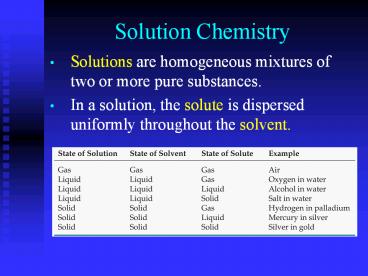Solution%20Chemistry - PowerPoint PPT Presentation
Title:
Solution%20Chemistry
Description:
Solution Chemistry Solutions are homogeneous mixtures of two or more pure substances. In a solution, the solute is dispersed uniformly throughout the solvent. – PowerPoint PPT presentation
Number of Views:569
Avg rating:3.0/5.0
Title: Solution%20Chemistry
1
Solution Chemistry
- Solutions are homogeneous mixtures of two or more
pure substances. - In a solution, the solute is dispersed uniformly
throughout the solvent.
2
Suspensions
- If the particles in a solvent are so large that
they settle out unless the mixture is constantly
stirred or agitated, the mixture is called a
suspension. - ?
3
Colloids
- Means glue in Greek
- A colloid is a mixture that contains solid
particles that are small enough to remain
suspended due to the motion of molecules - Examples
- Paint - solid dispersed in liquid
- Milk liquid dispersed in liquid
- Shaving cream gas dispersed in liquid
- Smoke solid dispersed in gas
4
- Many colloids look similar to solutions because
their particles cannot be seen. - The Tyndall effect can be used to distinguish
between a solution and a colloid. - The Tyndall effect occurs when light is scattered
by colloidal particles dispersed in a medium. - example a headlight beam is visible from the
side on a foggy night
5
Factors Affecting the Rate of Dissolution
- Surface area of the solute is increased
- Stirring or shaking
- Higher temperatures
- Remember, dissolution is a physical changeyou
can get back the original solute by evaporating
the solvent. - If you cant, the substance didnt dissolve, it
reacted.
6
Types of Solutions
- Saturated solution contains the maximum amount
of dissolved solute (undissolved solid remains in
the flask) - Unsaturated solution contains less than the
maximum amount of solute for a given temperature
(no solid remains in flask) - Supersaturated solution solvent holds more
solute than is normally possible at that
temperature.
7
Supersaturated solutions
These solutions are unstable. Crystallization
can often be stimulated by adding a seed
crystal or scratching the side of the flask.
8
Solubility
- Solubility the amount of substance required to
form a saturated solution with a specific amount
of solvent at a given temperature - example The solubility of sugar is 204 g per 100
g of water at 20C - Scientists often use Like dissolves like as a
rough but useful rule for predicting whether one
substance will dissolve in another.
- Polar substances tend to dissolve in polar
solvents. - Nonpolar substances tend to dissolve in nonpolar
solvents.
9
Liquid Solutes and Solvents
- Oil and water do not mix because oil is nonpolar
whereas water is polar. - Liquids that are not soluble in each other are
immiscible. - Liquids that dissolve freely in one another in
any proportion are miscible.
10
Effects of pressure on solubility
- The solubility of liquids and solids does not
change with pressure. - The solubility of a gas in a liquid is directly
proportional to its pressure. - (Increasing pressure above a solution forces more
gas to dissolve.) Known as Henrys Law
The rapid escape of a gas from a liquid in which
it is dissolved is known as effervescence.
11
Effects of temperature on solubility
- Increasing the temperature usually increases
solubility of solids in liquids
12
Effects of temperature on solubility
- However the opposite is true for gases.
Increasing the temperature usually decreases gas
solubility
- Carbonated soft drinks are more bubbly if
stored in the refrigerator. - Warm lakes have less O2 dissolved in them than
cool lakes.
13
Concentration
- The concentration of a solution is a measure of
the amount of solute in a given amount of solvent
or solution. - The opposite of concentrated is dilute.
14
Molarity (M)
- Molarity is the number of moles of solute in one
liter of solution - The symbol for molarity is M.
- To calculate molarity, you must know the amount
of solute in moles and the volume of solution in
liters.
15
- Sample Problem A
- You have 3.50 L of solution that contains 90.0 g
of sodium chloride, NaCl. What is the molarity of
that solution? - Given solute mass 90.0 g NaCl
- solution volume 3.50 L
- Unknown molarity of NaCl solution
- Solution
16
- Sample Problem B
- You have 0.8 L of a 0.5 M HCl solution. How many
moles of HCl does this solution contain? - Given volume of solution 0.8 L
- concentration of solution 0.5 M HCl
- Unknown moles of HCl in a given volume
- Solution
17
Molality (m)
- Molality is the concentration of a solution
expressed in moles of solute per kilogram of
solvent. - The symbol for molality is m.
- Molality is used when studying properties of
solutions related to vapor pressure and
temperature changes, because molality does not
change with temperature.































